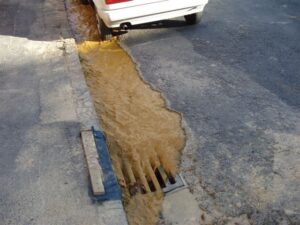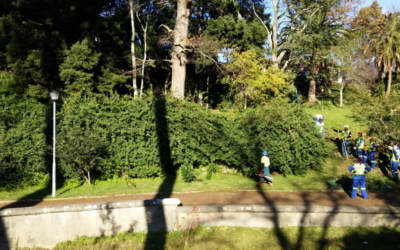How does this…………………………………………………….
get into the Liesbeek?
The reality is that the storm water drains vent into the Liesbeek and for a long time city engineers have treated the Liesbeek as a storm water drain itself, opting to canalise and channelise the river over a large part of its course.
On 26th March, 2011, a concerned member of the public who had noticed that the river was running brown and murky at Kildare Road Bridge, reported the problem to the city but it was only much later, when the source of the pollution was found, that the problem was addressed.
James Cooper, Friends of the Liesbeek River Warden, along with City officials, discovered that a developer working on a building site on Herschel Close had been pumping mud straight from the building site into the street, to flow down the gutter into the storm water drain.
When we checked on 11th April the damage was already extensive as the storm water drain had still been used to dispose of the mud until 7th April . Under Kildare Bridge, where the storm water drain vents, a layer of mud about 30cm deep was covering the river bed. A mini SASS survey done on 11th April revealed that effectively all life had been smothered in the thick mud, in contrast to the abundant small animals present just metres further upstream and further downstream.
Now the problem was to get the mud removed. What was complicated about simply removing the mud? As we have come to realise, nothing is simple, and here we were faced with what the developer, the city departments and even government bodies saw as needed to be done – mostly in terms of paper being pushed around – before any work could commence.
We held our breaths while a light rain fell on 20th April, washing some mud downstream. Luckily Thursday remained dry and finally pumping could start. It was hoped that the procedure would be completed by Saturday 23rd April without too much mud floating downstream. It has rained again on Sunday and we would appreciate any feedback on mud being washed downstream.
It took almost a month before the pollution was stopped and remedied – is this acceptable? What if the mud was contaminated? Residents walk along the Liesbeek every day, their dogs often enter the water, and it is difficult to keep children out of the enticing shallows. There are a large number of homeless people living on the Liesbeek, for better or worse, and they use the Liesbeek for their ablutions. Homeowners and businesses also pump water from the Liesbeek to water their gardens – they run a serious risk if the water is polluted.
It is very important that the City, under whose responsibility the Liesbeek falls, should have a prompt and effective disaster response plan in place that is well advertised and in working order. The Friends of the Liesbeek urge all residents to demand this.



